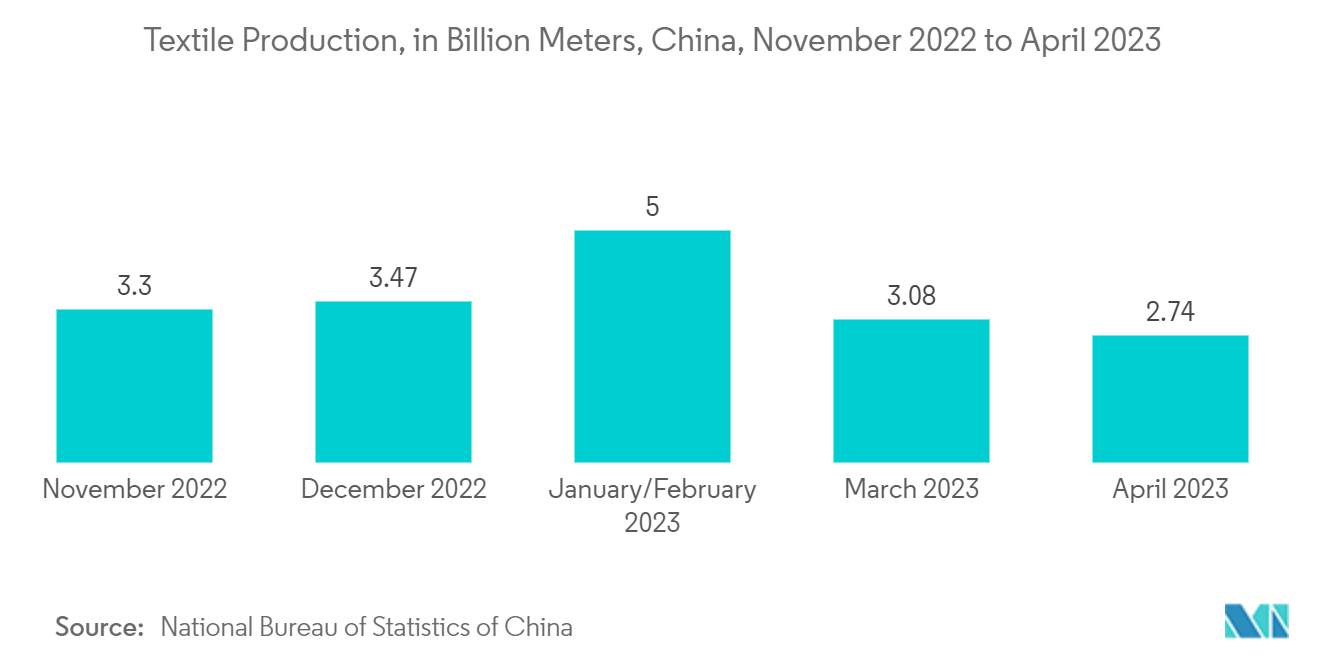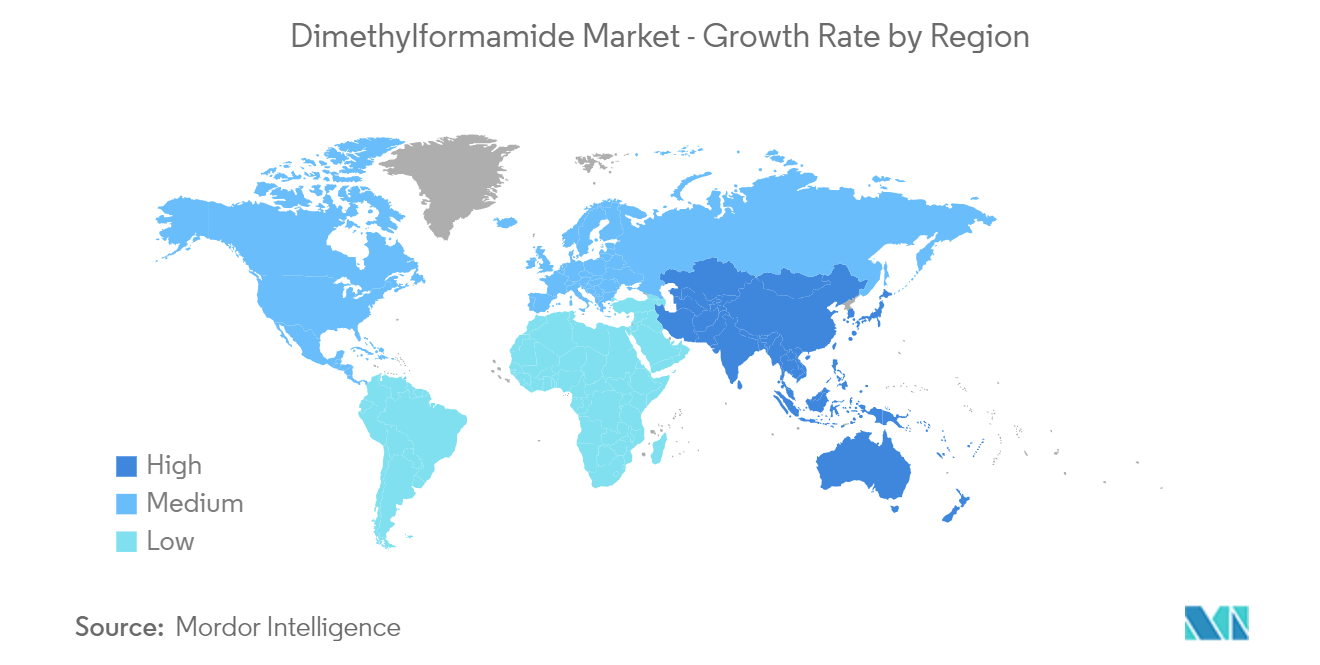Market Trends of Dimethylformamide Industry
Growing Demand from the Textiles Industry
- Dimethylformamide (DMF) is used to make polyurethane (PU) slurry. The slurry is a liquid combination of polyurethane resin, fillers, and additives used as a coating in the leather and garment industries.
- In addition, PU slurry is utilized in the manufacture of synthetic leather. The synthetic leather manufacturing process includes PU slurry preparation, coating application, drying and curing, and finishing.
- DMF is frequently used as a dye and pigment solvent in textile dyeing and printing operations. It aids in the dissolution of the dyes and their equal distribution over the fabric, resulting in brilliant and consistent colors.
- It is also used as a solvent in manufacturing synthetic fibers such as acrylic, spandex, and polyurethane. It aids in dissolving and stabilizing polymer solutions before extrusion via spinnerets to generate continuous fibers.
- DMF is also used as a solvent for various textile and footwear coatings, finishes, and resins. It facilitates the dissolution of coating ingredients and allows for consistent distribution on the fabric's surface, improving qualities such as water repellency, flame retardancy, and durability.
- According to the National Bureau of Statistics of China, textile output in China was 2.74 billion meters in April 2023 and 3.08 billion meters in March 2023.
- Moreover, according to the India Brand Equity Foundation, India's textile and apparel exports (including handicrafts) were worth USD 21.15 billion from April to October 2023. The sector is anticipated to be worth USD 190 billion by 2025-2026,
- Furthermore, the National Council of Textile Organizations (NCTO) reported that textile and apparel shipments from the United States were worth USD 65.8 billion. The country is the world leader in textile research and development, emphasizing producing antimicrobial fibers, life-saving body armor, and innovative climate-adaptive materials.
- The Asia-Pacific area accounts for a sizable portion of the footwear industry. Regarding manufacturing and sales, China and India are the region's leaders. In China, big footwear manufacturers, including Nike, Skechers, and Adidas, reported robust sales increases following the easing of lockdowns. According to these companies' statistics, traffic in China has returned to normal following a slowdown in December, with a robust increase around the Chinese New Year.
- Therefore, the demand in the textile industry is expected to increase the demand for dimethylformamide during the forecast period.

Asia-Pacific Region to Dominate the Market
- Asia-Pacific is expected to lead the world market because its chemical processing, pharmaceutical, and textile industries are well-developed.
- The textile industry uses DMF to make acrylic fibers, polyurethane products, fake leathers, films, and surface coatings. The International Trade Administration says that Asia-Pacific is the textile industry's biggest market.
- Chemical processing industries such as agricultural, petrochemical, polymer, and refining heavily use dimethylformamide for various applications. India has now been ranked sixth among the world's ten largest manufacturing countries. The petrochemical industry contributes about 30% of raw materials to the chemical industry, which is expected to reach USD 300 billion by 2025.
- Acrylic fibers are used in sweaters, boots, hats, gloves, athletic wear, carpeting, blankets, protective clothing, wigs, and hair extensions. This increased the demand for dimethylformamide in the production of acrylic fibers.
- The production value of China's textile and garment sector achieved a new export peak in 2022, with a trade surplus of more than USD 300 billion.
- According to statistics from the General Administration of Customs of China, the total value of China's textile and apparel exports in 2022 grew by 2.5% yearly. China will remain the world's leading textile and apparel exporter in 2022, with exports exceeding USD 300 billion for the third consecutive year. Exports from the entire leather supply chain increased by 19.3% year over year, while imports decreased by 12.3% year over year.
- China shipped 9.29 billion pairs of shoes in 2022, a 6.6% increase over 2021. Furthermore, China exported 720 million pairs of leather footwear valued at USD 11.46 billion, up 7.8% and 14.9% yearly. Meanwhile, the overall import value of leather shoes was 71 million pairs and USD 2.8 billion, representing a 0.2% and 0.8% decrease from the previous year.
- India exports 78% of its footwear to Europe and the United States. In 2022, the Indian footwear market's revenue is expected to be USD 23.73 billion. The leather footwear category is the market's largest, valued at USD 16.62 billion in 2022. By 2027, the Indian footwear industry will be worth roughly USD 27.84 billion.
- In July 2022, Covestro announced the establishment of two new polyurethane dispersions and elastomer manufacturing plants in Shanghai. These new facilities, placed within Covestro's integrated site in Shanghai, will represent a total investment in the mid-double-digit million-euro range.
- Dimethylformamide is used to make agriculture pesticides and clean up chemicals in the petrochemical industry. It also makes inks and dyes for printing and dying fibers. According to the National Bureau of Statistics of China, around 226,000 metric tons of chemical pesticides were manufactured in China in March 2023.
- Yuanfar Chemical announced intentions to increase its domestic dimethylformamide (DMF) production capacity by 100,000 tons in November 2022. The company is based in Jiujiang City, Jiangxi Province, and is owned by Henan Heart to Heart Group. As a result, the overall manufacturing capacity is anticipated to rise to nearly 800,000 tons. Hualu Hengsheng also plans on building 1,50,000 metric tons of additional DMF plants in Jingzhou by the end of 2023.
- The increasing use of industrial solvents and the region's growing need for laboratory research and development will likely be the driving forces behind dimethylformamide in the coming years.


